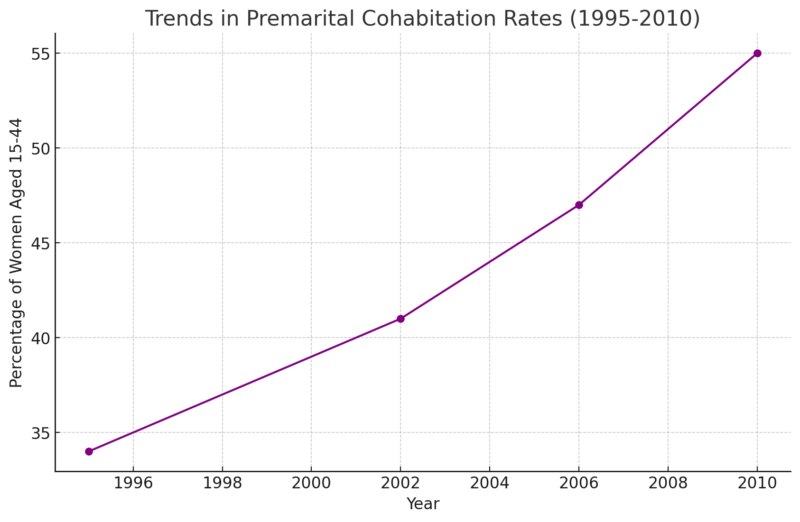Recent insights from the National Center for Health Statistics (NCHS) reveal significant shifts in the landscape of premarital cohabitation in the United States.
Drawing on data from the 2006–2010 National Survey of Family Growth (NSFG), the report offers a detailed look at how first premarital cohabitation has evolved over the past decades, focusing on trends related to pregnancies, racial and ethnic differences, and educational backgrounds.
Table of Contents
ToggleRising Rates of Premarital Cohabitation
The data highlights a marked increase in the prevalence of premarital cohabitation.
In 2006–2010, nearly 48% of women aged 15-44 had experienced cohabitation as their first union, a significant rise from 43% in 2002 and 34% in 1995 according to the CDC.
This shift underscores a growing acceptance and prevalence of cohabitation over traditional marriage as an initial step in relationships.
Decline in Marriage as a First Union
Accompanying the rise in cohabitation is a noticeable decline in the proportion of women entering marriage as their first union.
In 2006–2010, only 23% of first unions were marriages, down from 30% in 2002 and 39% in 1995 as per an NCBI study.
This decline reflects broader societal changes in attitudes towards marriage and cohabitation.
Duration and Outcomes of Premarital Cohabitation

The length of first premarital cohabitation has increased significantly.
Women in 2006–2010 spent an average of 22 months in their first cohabiting relationship, compared to 13 months in 1995.
Despite this longer duration, the stability and outcomes of these relationships varied.
By the three-year mark, 40% of cohabitation transitioned into marriage, while 32% remained intact without marriage, and 27% ended in dissolution.
Impact of Pregnancy on Marriage Likelihood
Pregnancy during the first year of cohabitation has become a common occurrence, with nearly 20% of women experiencing this situation.
However, the likelihood of marriage within six months of becoming pregnant has decreased significantly, dropping from 32% in 1995 to 19% in 2006–2010.
This decline suggests a shifting dynamic in how pregnancies are perceived and managed within cohabiting relationships.
Demographic Variations

The report also reveals significant demographic differences in cohabitation patterns:
Age of Cohabitation
Over 25% of women had cohabited by age 20, and nearly 75% had done so by age 30, indicating that cohabitation is becoming a common experience among younger women according to some reports.
Race and Ethnicity
- White Women: Among white women, almost half of premarital cohabitation transitioned to marriage within three years, with an average cohabitation duration of 19 months.
- Hispanic and Black Women: Foreign-born Hispanic women had the longest average cohabitation duration at 33 months, followed by black women at 27 months, and U.S.-born Hispanic women at 25 months. This variation underscores the influence of cultural and socio-economic factors on relationship dynamics.
Methodology
This article was based on a data-driven approach, primarily using the National Survey of Family Growth (NSFG) 2006–2010 data to analyze trends in premarital cohabitation. The information was supplemented by historical data from earlier surveys (1995, 2002) and additional research from CDC and NCBI to establish a comparative framework.
The article aimed to reflect changes in cohabitation and marriage by examining different demographic factors, including age, race, ethnicity, and pregnancy outcomes.
Key steps included:
- Data Collection: Used NSFG and CDC data to identify statistical trends.
- Comparison: Examined shifts over time (1995–2010) to show rising cohabitation and declining marriage rates.
- Demographic Analysis: Highlighted variations based on age, race, and ethnic groups, comparing the duration and outcomes of cohabitation.
Conclusion

The trends in premarital cohabitation reflect broader changes in societal norms and attitudes towards marriage and family formation. As cohabitation becomes a more common and extended experience, understanding these trends is crucial for policymakers, researchers, and individuals navigating the evolving landscape of relationships.
The data not only highlights shifting patterns but also provides a nuanced view of how different factors, including race, ethnicity, and pregnancy, impact the course and outcomes of premarital cohabitation.
References
- National Health Statistics Report – First Premarital Cohabitation in the United States: 2006–2010 National Survey of Family Growth
- Guzzo KB. Trends in Cohabitation Outcomes: Compositional Changes and Engagement Among Never-Married Young Adults. J Marriage Fam. 2014 Aug;76(4):826-842. doi: 10.1111/jomf.12123. Epub 2014 Jul 3. PMID: 26778851; PMCID: PMC4712741.
- .Foran HM, Mueller J, Schulz W, Hahlweg K. Cohabitation, Relationship Stability, Relationship Adjustment, and Children’s Mental Health Over 10 Years. Front Psychol. 2022 Feb 2;12:746306. doi: 10.3389/fpsyg.2021.746306. PMID: 35185668; PMCID: PMC8847607.
- TY – JOUR, AU – Copen, Casey ,AU – Daniels, Kimberly, AU – Vespa, Jonathan, AU – Mosher, William, PY – 2012/03/22 , SP – 1, EP – 21 , T1 – First Marriages in the United States: Data from the 2006–2010 National Survey of Family Growth, VL – 49, JO – National health statistics reports
- Foundation – LEGAL PRACTITIONERS’ PERSPECTIVES ON THE COHABITATION PROVISIONS OF THE FAMILY LAW (SCOTLAND) ACT 2006
Related Posts:
- U.S. Uninsured Rate by Year – 9 Key Trends Since 2010
- 3 Key Insights into Circumcision Trends in the U.S.…
- Federal Guidelines for Both Aerobic and…
- Valencia Spain Crime Rate 2025 - Trends and Analysis
- Heart Rate Variability Chart by Age - 2 Key Trends to Know
- Key Statistics About the U.S. Birth Rate in 2025








